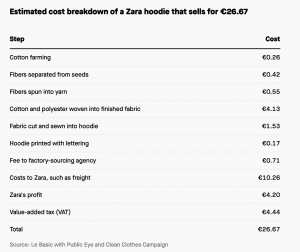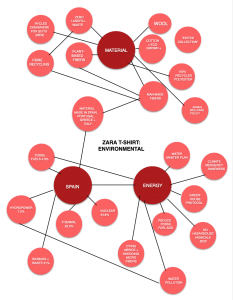Zara T-shirt
During the study of the t-shit me and Julia divided our work in justice and environmental sections. I took over environmental coming across a lot of information that I needed to contrast with other sources to find out how reliable it was, and if it was speaking in past, present or future to come to a life cycle analysis conclusion of the t-shirt. The more I kept finding information about the item, I came across a very interesting article that related to the breakdown of a t-shirt made by ZARA. Although they are one of the most successful companies in the fashion industry, marking their t-shirt at $29.50 it is not very sustainable for the workers. Public Eye, a Swiss investigative group focused on human rights and corruption found out how the wages for the workers did not give them enough to live. I’m adding this information to my map as I believe the word ‘environment’ encapsulates more than the materials and how eco-friendly the products of products are, but also the surrounding in which the people producing these items are feeling safe, respected and acknowledged.
Public Eye made a hoodie with the words ‘R-E-S-P-E-C-T’ producing it in Turkey as Zara claims to produce up to 57% of their products here, Spain, Portugal and Morocco. Then they asked to go to the factories of ZARA and after some argument they were able to estimate the cost of the production of a hoodie.
After this examination they were also to determine the the breakdown of how Zara pays their workers.
Although these are all just estimates, and me and my partner were looking at a t-shirt and not a hoodie, I think it is very important to give light to this information even if it is somewhat ‘speculation’ just to understand how not environmentally friendly this brand is, even though their massive global expansion and influence. This can be an example of Zara’s design for resilience. Their size is what makes them be able to do this design and take advantage of it, even going against their own policies as stated in their code of conduct “wages should always be enough to meet at least the basic needs of workers and their families and any other which might be considered as reasonable additional needs.”. If a smaller brand tried to do this, it would simply not work out.
Another study talks about the longevity of a Zara t-shirt making it only last 10 wears. This can be an arguable cradle-to-cradle vs cradle-to-grave. I would use it as an example of cradle-to-grave. Although you can reuse it after one use, the end purpose is to be thrown away because it is simply just made this way on purpose… to contribute sales and continue their circular economy of the number of garments the average person purchases each year that increases by 60 percent. So the question we would be asking here is; Is Zara focused about the future of sustainability and ethical fashion? I think not. After those 10 wears, where does all these clothes go to? We either throw it away, adding to landfill mountains, take it to second hand stores, instead of maybe going back to Zara, bringing the item with you, and for every item you bring back you receive a discount on your next purchase to encourage society to think about sustainability and other possibilities. This is the perfect example of what anthropocene means: We are literally damaging with product waste the Earth and it is not being acknowledged officially. Apparently it is socially acceptable to throw away clothes, not realizing the long-term impact this will have on future generations and ‘baggage’ they will have to carry to solve the problems we are creating today.
Moreover, I decided to focus on Spain in my infographic because it is the country I relate to the most as it is my home country. It was interesting to see all of different factors interjoin towards each other and how dependent this type of ‘economy’ has become. Although I added some ways Zara reuses cashmere, fibres, polyester, etc… I am not really sure how accurate this information can be due to the unreliability as proven before by Public Eye study.
Overall, as discussed before Zara turns out not to be very sustainable, regardless of advertising they try to make for the audience, it just another technique to ‘seduce’ consumers into buying more, and not knocking any sense of reality to the BTS of their company or actually contributing to society to maybe spreading a positive message and using their platform for a better purpose than fast fashion.




